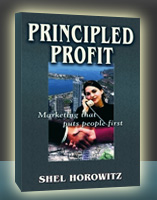Five Easy Ways To Tell If An Organization Is Really Values-Driven
|
By Jesse Lyn Stoner, co-author Full Steam Ahead! Unleash the Power of Vision What do Zappos, Ben and Jerry’s, and Southwest Airlines have in common? They are all financially successful, values-driven companies. A lot of companies claim to be values-driven. They publish their values and use them in marketing messages. However, this does not necessarily mean their values guide decision-making and behaviors company-wide on a day-by-day basis. To know for sure, you can investigate whether leadership practices and company policies are aligned with their published vision and values. But there’s a simpler and quicker way to tell: pay attention to your own experience as a customer. Ask three employees what the values of the company are.
I recommend that companies choose no more than five values because you want your values to be forefront in people’s minds, and it’s hard to remember more than five. Interestingly, Zappos is so totally focused on their values that they have listed ten values that employees actually remember. Check out this great video of Zappos employees talking about their company’s values. 2. Employees can describe specific activities and behaviors that demonstrate what the values look like in action. Ask the employees to give you examples of how the values they listed are lived in the company –what behaviors or actions do they see that exemplify each of the values? It’s not enough to just have a list of values. The same words can mean different things to different people. Values like “teamwork” “innovation” or “ownership” need to be clearly defined so they are understood by all and can be implemented consistently. I recommend including 4 or 5 descriptors to give meaning to the words. For example, one company I worked with defined “ownership” as:
Providing descriptors like these enables employees and customers to have clear conversations about what should be happening. And it provides a way to determine whether the values are being lived consistently. 3. The company’s values are visibly integrated into how they do business and are not just something extra they do on the side. It is common knowledge that since its inception, Ben and Jerry’s has built a reputation for caring more about people than profit, providing leadership in social and environmental responsibility. And although the company was sold to Unilever in 2000, CEO Jostein Solheim recently provided reassurance that the essence has not changed, stating “The world needs dramatic change to address the social and environmental challenges we are facing. Values led businesses can play a critical role in driving that positive change. We need to lead by example, and prove to the world that this is the best way to run a business. Historically, this company has been and must continue to be a pioneer to continually challenge how business can be a force for good and address inequities inherent in global business.” So far Solheim has kept true to his word. If that changes, we consumers will quickly know. 4. The company’s public message matches your own experience as a customer. My advice to companies is Don’t make a claim and then miss the mark, consistently. We consumers resent it and you actually lose credibility. Recently in an attempt to resolve a problem with AT&T, I was forced to call customer service five times. Each time I heard this exact phrase at the end of the conversation: “My goal is to provide satisfying customer service. Can I help you with anything else?” Obviously they hadn’t helped me in the first place or I wouldn’t have been forced to call five times on the same issue. When the customer service representative repeats the same canned phrase at end of each conversation, regardless of whether the issue was resolved, the company loses credibility. McDonald’s wants to change its image by promoting a new initiative “to help children and families make nutrition-minded choices.” What are they going to do? They’re adding apples to the Happy Meal. As a consumer, I have to say that just doesn’t do it for me. In the early 60s, AVIS coined the famous tagline: “We’re only #2 in rental cars, so why go with us? We try harder.” In his April, 2011 article, Alan Armstrong makes the following point: Lately AVIS has re-adopted part of that tagline, but only part of it. They’ve dropped the important pre-cursor and kept the memorable ending, “We Try Harder”. The trouble is, “We try harder” is only believable if your market perceives that you really do try harder. In order to believe that, they have to see you as an underdog. It is very difficult to convince the customer that AVIS, now about the same size as Hertz, will really try harder. 5. Use your own personal experience to identify the real company values. Anyone who has flown on Southwest Airlines can tell you without reading their ads that having fun is one of their core values. And indeed, on the careers page of their Website, Southwest Airlines recruits specifically for people who “want the freedom to be creative, dress casually, and have fun on the job.” Recently a friend told me of an experience that clearly demonstrates their values: during takeoff the flight attendants announced they were tired and didn’t feel like serving the peanuts and pretzels that day. They had decided to roll them down the aisle during takeoff instead and passengers were welcome to help themselves. And that’s exactly what happened. Passengers grabbed items as they rolled by and had a great time tossing them to each other. If you complain about the flight attendants’ creative antics, they will not be reprimanded (as long as safety has not been compromised). Instead, you will be told you’ll be missed if you decide to fly on another airline in the future. It’s not very difficult to tell if an organization is really values-driven. What has your experience been recently? Have you observed any values-driven companies in action?
Jesse Lyn Stoner is founder of Seapoint Center, helping leaders identify a compelling and unifying vision, co-author of the international bestseller Full Steam Ahead: Unleash the Power of Vision, and author of the popular team assessment Benchmarks of Team Excellence. She blogs at Jesse Lyn Stoner Blog, where this article first appeared, at https://seapointcenter.com/values-driven-organizations/ |


 Shel specializes in affordable, ethical, and effective marketing for authors, publishers, small businesses, nonprofits, and community groups. Copywriter, marketing and publishing consultant, international speaker, and award-winning author of seven books.
Shel specializes in affordable, ethical, and effective marketing for authors, publishers, small businesses, nonprofits, and community groups. Copywriter, marketing and publishing consultant, international speaker, and award-winning author of seven books.